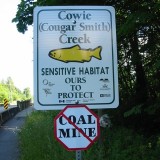The recently released Application Information Requirements/Environmental Impact Statement (AIR/EIS) Guidelines Document on the Raven Underground Coal Mine Project signals the end of the Pre-application Stage of the Environmental Assessment (EA) process and sets the table for the next stage, which is the Application Stage. This AIR/EIS document is partly the culmination of several years of public consultation, which included 3 public meetings and 3 public comment periods, resulting in a near record 5,000 written comments submitted. Over 95% of the written comments expressed concern or opposition to the project.
In theory, the purpose of the public consultation was to produce an AIR/EIS that would adequately address the public concerns about the massive coal mine’s negative impacts on the region’s water aquifers, the Baynes Sound shellfish industry, air and noise pollution, and socio-economic issues, just to name a few. Not surprisingly, the early reviews of the AIR/EIS show a document that is largely deficient, and the AIR/EIS has not adequately addressed the public’s concerns. Since the proponent’s application will be based on the AIR/EIS document, it’s clear that the application will be flawed and not address the public’s numerous and legitimate concerns, and moreover the future EA process on this project will not be rigorous or comprehensive.
Despite widespread public concern and opposition, and the lack of a social license being granted by the residents of the Comox Valley and Port Alberni, the EA process continues to move forward. However, the huge public outcry over the coal mine proposal is growing louder every day and the communities impacted by the Raven Mine are united more than ever in their opposition to this insane proposal.
In the coming months we’ll continue to strengthen our message of concern and opposition to the Raven Mine, and make it clear to our local, provincial, and federal elected officials that this project is unacceptable. With the provincial election just around the bend, you never know, some of them might actually listen.
A lot of twists and turns left to go in this saga, and as Yogi Berra once said, “It ain’t over ‘til it’s over.” Stay tuned.
John Snyder is a resident of Fanny Bay, BC, and the president of CoalWatch Comox Valley


There are so many reasons to oppose the Raven coal mine; destruction of fish habitat, pollution of the watershed, toxic coal dust in the air, the destruction of the airshed in Port Alberni, the poisoning of the Alberni Inlet, traffic safety, destruction of bird habitat, potential loss of 600 shellfish workers’ jobs. The management team of Compliance are like characters in a bad movie. They seem to think that because people drive cars it should be acceptable for them to destroy ecosystems for their own profit. They have mineral rights to 29000 hectares in the beautiful Comox Valley and rights to coalbed methane. The Raven mine would be a foot in the door for them. They have plans for two more mines in the Valley, both open pit, and four other mines on Vancouver Island. There is fierce opposition to the mine in the Valley with many people willing to risk arrest if our government is dumb enough to give them a permit. A pox on all of them! They shall not pass!
John is still spreading his disinformation about this project at every opportunity. No mine application in BC has had more scrutiny than this one. CoalWatch has been unable to show how the shellfish industry will be impacted considering how long the coal industry operated in the area with negligible effect on shellfish or fin fish. Coal was coked and loaded on to ships right in Union Bay for 8 decades in the heart of Baynes Sound where the shellfish industry is thriving today. The inadequate sewage systems of Fanny Bay residents is of much greater concern than UNREGULATED coal mine could have let alone one operating under today’s regulations and local scrutiny. A quick plane ride over the area will show that the logging industry’s unfettered harvesting is the largest concern for water quality in the streams and rivers yet not a word from CoalWatch; why? Is John willing to give up his share of products made from steel which this coal is vital to produce such as his vehicle or frying pans etc.? Not likely. Even the shellfish industry is completely dependent on steel products to function so where do they think the coal should come from for their business to carry on? Mine responsibly.
That is a really good tip especially to those fresh to the blogosphere.
Simple but very precise info Thank you for sharing
this one. A must read post!